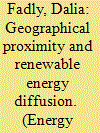| Srl | Item |
| 1 |
ID:
166559


|
|
|
|
|
| Summary/Abstract |
In an era where achieving both economic growth and environmental sustainability is paramount, the role of technology diffusion remains an important one. Recent literature explores the link between geographical proximity and the adoption and diffusion of climate change adaptation policies. However, it has generally focused on a restricted set of developed countries and focused on the diffusion of policy instrument rather than the outcome of the policies. In this paper, we argue that domestic intensity of adoption of renewable energy technologies is likely to be affected by the adoption pattern in neighbouring countries. Additionally, this effect is likely to be stronger when important trade partners are intensive adopters of renewable energies. To test these hypotheses, we construct an index that captures a distance-weighted measure of intensity of renewable energies in other countries and apply a fixed effects framework to a panel of up to 116 countries over the (1980–2012) period. Our results confirm the existence of a geographic spill-over effect on the intensity of adoption of renewable energy technologies. Moreover, this effect is stronger when intensive adopters of renewable energies are also important trading partners, highlighting the relevance of trade channel as a potential catalyst of the diffusion of renewable energies across countries.
|
|
|
|
|
|
|
|
|
|
|
|
|
|
|
|
| 2 |
ID:
115645


|
|
|
|
|
| Publication |
2012.
|
| Summary/Abstract |
This paper models the adoption of commercial building energy codes in the US between 1977 and 2006. Energy code adoption typically results in an increase in aggregate social welfare by cost effectively reducing energy expenditures. Using a Cox proportional hazards model, I test if relative state funding, a new, objective, multivariate regression-derived measure of government capacity, as well as a vector of control variables commonly used in comparative state research, predict commercial building energy code adoption. The research shows little political influence over historical commercial building energy code adoption in the sample. Colder climates and higher electricity prices also do not predict more frequent code adoptions. I do find evidence of high government capacity states being 60 percent more likely than low capacity states to adopt commercial building energy codes in the following year. Wealthier states are also more likely to adopt commercial codes. Policy recommendations to increase building code adoption include increasing access to low cost capital for the private sector and providing noncompetitive block grants to the states from the federal government.
|
|
|
|
|
|
|
|
|
|
|
|
|
|
|
|